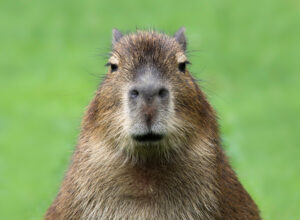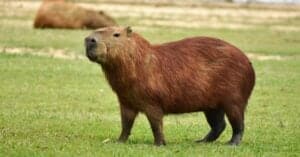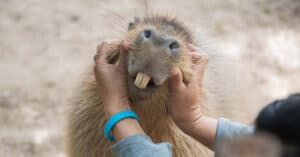If you’re looking for an animal that’s as cute as it is quirky, the capybara is definitely worth a look. This rodent is the largest of all living members of the family Caviidae, which also includes guinea pigs and porcupines. Capybaras are native to South America, where they enjoy swimming, diving, and playing in the water. These animals are highly social and can often be seen sunbathing and swimming in rivers and ponds. And thanks to Chispi from Disney’s 2021 film Encanto, we know that there are capybaras in Colombia — but where else can you find these cute creatures? Let’s take a closer look at where capybaras live, what kinds of habitats they prefer, and where they have traveled!
Where Do Capybaras Live?
South America
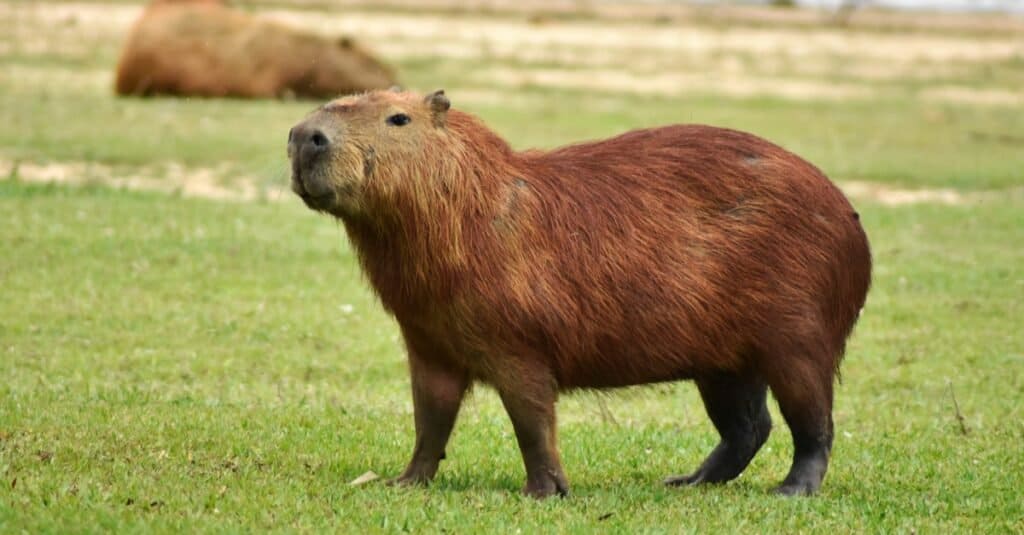
The capybara species in South America are the common capybara and the lesser capybara.
©Horus2017/Shutterstock.com
There are two species of capybaras that live in South America: the common capybara, and the lesser capybara. The lesser capybara is a bit smaller and lives mostly in Panama. The common capybara, on the other hand, lives all throughout South America in places like Venezuela, Colombia, Guyana, Suriname, Ecuador, Peru, Brazil, Argentina, Paraguay, Uruguay, and Bolivia. One of the only places lacking capybaras is Chile since these giant rodents cannot make it over the Andes Mountains to get there!
Florida
Interestingly, although the capybara is native to South America, there have been a few accounts of capybaras in other countries far from their native range. While there is no officially confirmed population yet, there have been many sightings of capybaras in the United States! A number of capybaras have been seen all over the state of Florida (to see where, check out this map).
The capybaras spotted in Florida are most likely released pets or capybaras that escaped captivity. So far, they have not posed much threat to the natural environment or humans. However, they can occasionally raid farms or gardens looking for squash, melons, and grains.
Japan
Remarkably, the capybara has become a beloved animal far across the world in Japan. During the 1960s, several capybaras were taken to Japan to be housed in zoos. Their social, gentle nature made them a hit with the people. Zoos and animal parks in Japan continue to provide their resident capybaras with an onsen, or their own custom-made hot springs. There is a popular cartoon capybara named Kapibarasan in Japan as well.
What is the Native Habitat of Capybaras?
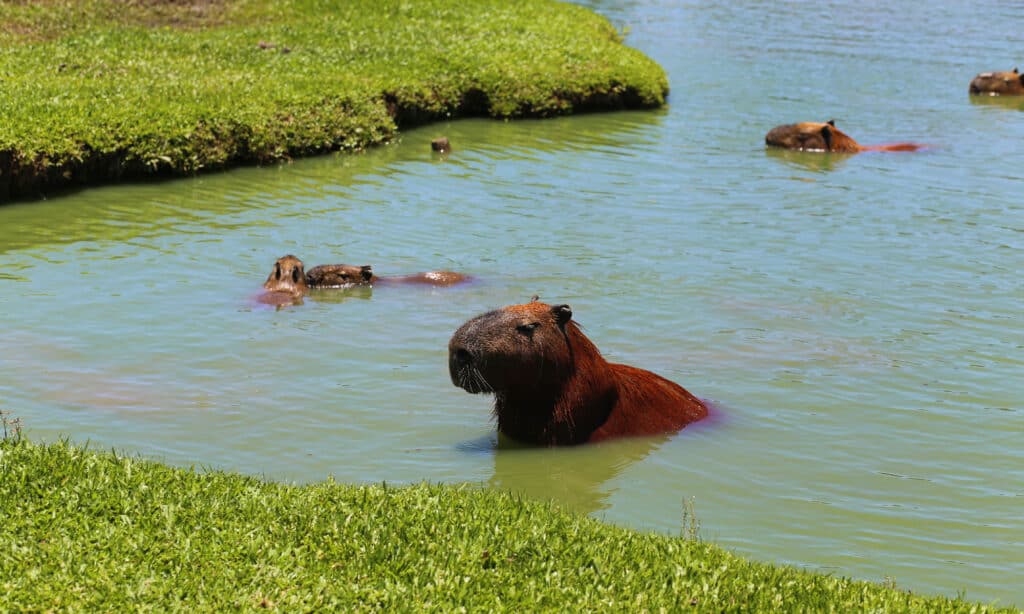
Capybaras are both semi-aquatic and land animals.
©mcpslima/Shutterstock.com
Capybaras are land mammals, but they are also semiaquatic. They inhabit areas with dense vegetation and close proximity to water sources, such as marshes, swamps, lakes, ponds, and rivers. Their favorite habitats are lowlands close to water. However, when the season changes, they are also quite fond of flooded grasslands and savannahs. Their typical home range usually spans 25 acres where they roam and graze for food.
Some capybaras even take up residence in agricultural fields and human settlements near these water sources if available. Many have been known to flourish fabulously in cattle ranches, although this can cause a problem for the resident cattle. Capybaras in Florida are usually found in the state’s mangrove swamps, wetlands, and along forested riverbanks.
Capybara Habitats and Biomes
The natural habitat of capybaras is made up of three different biomes: rainforests, savannas/grasslands, and wetlands.
Capybaras in Rainforests: A majority of the year is rainy in tropical rainforests which means that there is an abundance of freshwater available for these animals to drink. The dense vegetation in rainforests also provides ample opportunities for capybaras to hide from predators and escape the hot sun.
Capybaras in Savannas/Grasslands: During the dry season in savannas and grasslands (which can last up to eight months), capybaras will find refuge near water sources such as ponds and lakes. The long stretches of grass provide cover from predators but can also make it difficult for capybaras to spot potential threats.
Capybaras in Wetlands: Wetlands are habitats with saturated soils that support aquatic plants. These areas include marshes, swamps, bogs, and fens. During the wet season, wetlands fill with water from precipitation or groundwater. This makes it difficult for some animals to access food and shelter but provides an ideal environment for capybaras. The presence of water also helps these animals regulate their body temperature as they are susceptible to heat stress.
Capybaras and Water
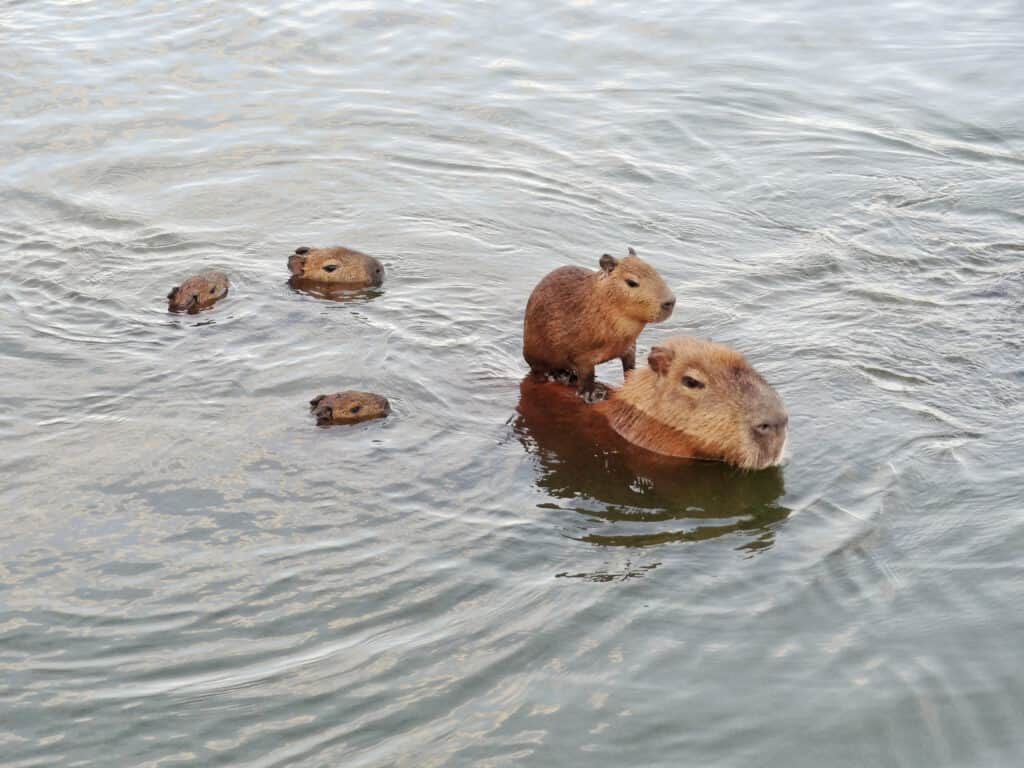
Mother capybaras often carry their babies while swimming in the water.
©iStock.com/Yuina Takase
These unique animals love the water and spend nearly their entire day in it or in nearby dense vegetation. In fact, the scientific name for the capybara (Hydrochoerus hydrochaeris) comes from the Greek words “water” and “pig” or “hog.” These large, semiaquatic rodents are excellent swimmers and can even hold their breath for up to five minutes underwater! While they are surprisingly agile on land, they are as equally nimble in the water as well. Some capybaras will even sleep underwater, with just their noses poking out above the surface.
While these giant rodents may look like hairy pigs or oversized guinea pigs, their toes are actually partially webbed, which allows them to paddle and swim with ease. Their fur is more like coarse and brittle hair, which helps capybaras to dry quickly when they return to land after a swim.
Water as a Natural Escape Route
Living in and near water comes in handy for capybaras, who are often prey to larger predators. When swimming, capybaras will often tip their heads above the surface to take a breath while keeping the rest of their bodies submerged. Their eyes, nostrils, and ears are located toward the top of their heads, so they can use them while keeping the rest of their bodies underwater.
This lets them breathe and check on their surroundings while they are still submerged in the water, helping them avoid predators. Unfortunately for capybaras, these animals can easily become a meal for larger predators like alligators and jaguars. However, because of their semiaquatic skills, they can often escape predators by slipping into the water to hide.
Additionally, capybaras are herbivores, and their diet consists mostly of aquatic plants, grasses, fruits, and vegetables. They are generally pretty hardy animals and can tolerate extreme temperatures as long as they have enough water. However, if given the choice, capybaras much prefer warm climates with plenty of water. If the temperatures get too hot, they can easily spend the day wallowing in water or mud and then graze for food in the mornings and evenings.
Capybaras Live Together in Groups
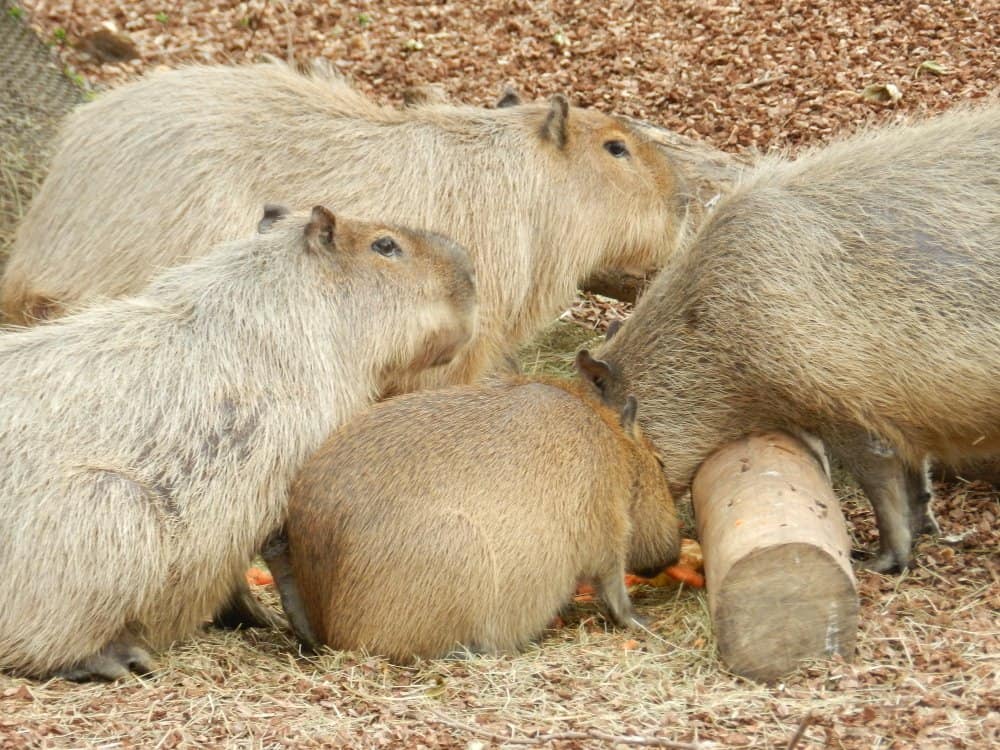
Capybaras live in groups.
©Millie Bond – Copyright A-Z Animals
These intriguing animals are very social creatures that usually live in groups of 10-20 individuals. However, on occasion, a group of capybaras may have 40 or more living together at once! Such a herd can be quite intimidating since capybaras can grow up to four or five feet in length and weigh up to 150 pounds. Capybaras are very vocal animals and communicate with each other through a variety of sounds and body language.
In many areas of South America, capybaras are hunted for their hide and meat. While the IUCN lists them as a “least concern” species due to the stability of their overall population, many capybara populations have been annihilated due to overhunting.
As you can see, capybaras have a variety of habitat requirements, but all revolve around being close to a freshwater source. Some capybaras may live alone, but generally, they prefer living in large groups. If you’re ever lucky enough to spot one of these amazing creatures in the wild, be sure to give them plenty of space. They are wild animals after all, but feel free to take lots of pictures.
Up Next:
- 10 Incredible Capybara Facts
- What Is a Group of Capybaras Called and How Do They Behave?
- What Do Capybaras Eat? Their Diet Explained
- Capybara Poop: Everything You’ve Ever Wanted to Know
- Do Capybaras Make Good Pets? Sweet Rodents with Special Needs
The photo featured at the top of this post is © Andrew M. Allport/Shutterstock.com
Thank you for reading! Have some feedback for us? Contact the AZ Animals editorial team.



